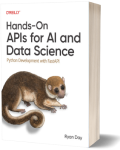Hands-On APIs for AI and Data Science
Artificial Intelligence
Book Details
Book Title
Hands-On APIs for AI and Data Science
Author
Ryan Day
Publisher
O'Reilly Media, Inc
Publication Date
2025
ISBN
9781098164416
Number of Pages
744
Language
English
Format
File Size
5.7MB
Subject
Artificial Intelligence
Table of Contents
- Preface
- I. Building APIs for Data Science
- 1. Creating APIs That Data Scientists Will Love
- How Do Data Scientists Use APIs?
- What Tools Do Data Scientists Use?
- Designing APIs for Data Scientists
- Introducing Your Part I Portfolio Project
- Every API Has a Story
- Selecting the First API Products
- Additional Resources
- Summary
- 2. Selecting Your API Architecture
- API Architectural Styles
- Technology Architecture
- Software Used in This Chapter
- Getting Started with Your GitHub Codespace
- Additional Resources
- Summary
- 3. Creating Your Database
- Components of Your API
- Software Used in This Chapter
- Creating Your SQLite Database
- Accessing Your Data Using Python
- Additional Resources
- Summary
- 4. Developing the FastAPI Code
- Continuing Your Portfolio Project
- Software Used in This Chapter
- Copying Files from Chapter 3
- Installing the New Libraries in Your Codespace
- Creating Python Files for Your API
- Testing Your API
- Launching Your API
- Additional Resources
- Summary
- 5. Documenting Your API
- Sending a Signal of Trust
- Making Great API Docs
- Reviewing Examples of API Documentation
- Viewing Your API’s Built-in Documentation
- Working with Your OpenAPI Specification File
- Continuing Your Portfolio Project
- Updating Your README.md
- Additional Resources
- Summary
- 6. Deploying Your API to the Cloud
- Benefits and Responsibilities of Cloud Deployment
- Choosing a Cloud Host for Your Project
- Setting Up Your Project Directory
- Using GitHub Codespaces as a Cloud Host
- Deploying to Render
- Shipping Your Application in a Docker Container
- Deploying to AWS
- Updating Your API Documentation
- Additional Resources
- Summary
- 7. Batteries Included: Creating a Python SDK
- SDKs Bridge the Gap
- Picking a Language for Your SDK
- Starting with a Minimum Viable SDK
- Building a Feature-Rich SDK
- Completing Your Part I Portfolio Project
- Additional Resources
- Summary
- II. Using APIs in Your Data Science Project
- 8. What Data Scientists Should Know About APIs
- Using a Variety of API Styles
- HTTP Basics
- How to Consume APIs Responsibly
- Separation of Concerns: Using SDKs or Creating API Clients
- How to Build APIs
- How to Test APIs
- API Deployment and Containerization
- Using Version Control
- Introducing Your Part II Portfolio Project
- Getting Started with Your GitHub Codespace
- Running the SportsWorldCentral (SWC) API Locally
- Additional Resources
- Summary
- 9. Using APIs for Data Analytics
- Custom Metrics for Sports Analytics
- Using APIs as Data Sources for Fantasy Custom Metrics
- Creating a Custom Metric: The Shark League Score
- Software Used in This Chapter
- Installing the New Libraries in Your Codespace
- Launching Your API in Codespaces
- Creating an API Client File
- Creating Your Jupyter Notebook
- Adding General Configuration to Your Notebook
- Working with Your API Data
- Calculating the League Balance Score
- Calculating the League Juice Score
- Creating the Shark League Score
- Additional Resources
- Summary
- 10. Using APIs in Data Pipelines
- Types of Data Sources for Data Pipelines
- Planning Your Data Pipeline
- Orchestrating the Data Pipeline with Apache Airflow
- Installing Apache Airflow in GitHub Codespaces
- Creating Your Local Analytics Database
- Launching Your API in Codespaces
- Configuring Airflow Connections
- Creating Your First DAG
- Coding a Shared Function
- Running Your DAG
- Summary
- 11. Using APIs in Streamlit Data Apps
- Engaging Users with Interactive Visualizations
- Software Used in This Chapter
- Installing Streamlit and nfl_data_py
- Launching Your API in Codespaces
- Reusing the Chapter 9 API Client File
- Creating Your Streamlit App
- Updating the Entrypoint File
- Running Your Streamlit App
- Creating the Team Rosters Page
- Creating the Team Stats Page
- Deploying Your Streamlit App
- Completing Your Part II Portfolio Project
- Additional Resources
- Summary
- III. Using APIs with Artificial Intelligence
- 12. Using APIs with Artificial Intelligence
- The Overlap of AI and APIs
- Designing APIs to Use with Generative AI and LLMs
- Defining Artificial Intelligence
- Generative AI and Large Language Models (LLMs)
- Creating Agentic AI Applications
- Introducing Your Part III Portfolio Project
- Getting Started with Your GitHub Codespace
- Additional Resources
- Summary
- 13. Deploying a Machine Learning API
- Training Machine Learning Models
- New Software Used in This Chapter
- Installing the New Libraries in Your Codespace
- Using the CRISP-DM Process
- Business Understanding
- Data Understanding
- Data Preparation
- Modeling
- Evaluation
- Deployment
- Additional Resources
- Summary
- 14. Using APIs with LangChain
- Calling AI Using APIs (via LangChain)
- Creating a LangGraph Agent
- Installing the New Libraries in Your Codespace
- Creating Your Jupyter Notebook
- Chatting with the LangGraph Agent
- Running the SportsWorldCentral (SWC) API Locally
- Installing the swcpy Software Development Kit (SDK)
- Creating a LangChain Toolkit
- Calling APIs Using AI (with LangGraph)
- Chatting with Your Agent (with Tools)
- Additional Resources
- Summary
- 15. Using ChatGPT to Call Your API
- Architecture of Your Application
- Getting Started with ChatGPT
- Creating a Custom GPT
- Launching Your GitHub Codespace
- Running the SportsWorldCentral (SWC) API in GitHub Codespaces
- Adding the Servers Section to Your OAS File
- Creating a GPT Action
- Testing the APIs in Your GPT
- Chatting with Your Custom GPT
- Completing Your Part III Portfolio Project
- Summary
- Index
- About the Author
